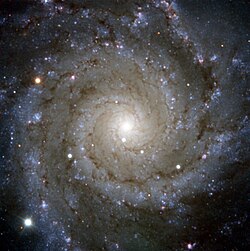Messier 74
| Messier 74 | |
 Supernovautbrott i M74 | |
| Observationsdata | |
|---|---|
| Stjärnbild | Fiskarna |
| Rektascension | 01t 36m 42s |
| Deklination | +15° 47′ 01″[1] |
| Rödförskjutning | 657 km/s |
| Avstånd | 30 ± 6 miljoner[2] ljusår |
| Typ | Stavgalax |
| Skenbar storlek | 10,5 x 9,5 bågminuter[3] |
| Skenbar magnitud | +9,39[1] |
| Upptäckt | |
| Upptäcktsår | september 1780 |
| Upptäckare | Pierre Méchain[4] |
| Andra beteckningar | |
| NGC 628, UGC 1149, PGC 5974, MCG +03-05-011, CGCG 460-14, IRAS 01340+1532, IRAS F01339+1532, 2E 440, PSCz Q01340+1532, M98c 013400.7+153155, 2E 0134.0+1531, ISOSS J01366+1547, TC 18, SLK2004 223, GB6 B0134+1531, VDD93 8, 87GB 013400.0+153119, 2MASX J01364177+1547004, UZC J013641.7+154659, HIPASS J0136+15, Z 0134.0+1532[1], GC 372 | |
| Se även: Galaxer, Lista över galaxer | |
Messier 74 (M74, också katalogiserad som NGC 628) är en frontalvänd spiralgalax i stjärnbilden Fiskarna.
Galaxen har två tydliga spiralarmar och används som ett skolexempel på spiralgalaxers struktur. M74 tillhör de Messierobjekt som är svårast att observera för amatörastronomer, på grund av galaxens låga ljusstyrka. För professionella astronomer är den däremot ett idealiskt observationsobjekt främst tack vare att galaxen är frontalvänd så att man har en perfekt vy över den.
Tre supernovor har identifierats i M74: SN 2002ap, SN 2003gd och SN 2013ej.

Misstänkt svart hål
Den 22 mars 2005 meddelades att Chandra-teleskopet upptäckt en ultraluminös röntgenkälla i M74, som utstrålade mer röntgenenergi än en neutronstjärna i periodiska intervall på omkring två timmar. Källan beräknades ha en massa på omkring 10 000 solmassor. Detta tyder på ett mellanstort svart hål.
Referenser
- ^ [a b c] ”Basic data: M 74 -- Galaxy” (på engelska). SIMBAD. Centre de Données astronomiques de Strasbourg. http://simbad.u-strasbg.fr/simbad/sim-basic?Ident=Messier+74&submit=SIMBAD+search. Läst 4 september 2014.
- ^ M. A. Hendry, S. J. Smartt, J. R. Maund, A. Pastorello, L. Zampieri, S. Benetti, M. Turatto, E. Cappellaro, W. P. S. Meikle, R. Kotak, M. J. Irwin, P. G. Jonker, L. Vermaas, R. F. Peletier, H. van Woerden, K. M. Exter, D. L. Pollacco, S. Leon, S. Verley, C. R. Benn, G. Pignata (2005). ”A study of the Type II-P supernova 2003gd in M74”. Monthly Notices of the Royal Astronomical Society 359 (3): sid. 906–926. doi:.
- ^ ”Images and maps in NED archive for object Messier 074” (på engelska). NASA/IPAC Extragalactic Database. http://ned.ipac.caltech.edu/cgi-bin/imgdata?objname=Messier+74. Läst 4 september 2014.
- ^ ”Full name of NGC discoverers” (på engelska). NASA/IPAC Extragalactic Database. Arkiverad från originalet den 28 februari 2011. https://web.archive.org/web/20110228034511/http://www.ngcicproject.org/erdmann/NGC_Discoverers_01.txt. Läst 4 september 2014.
Externa länkar
 Wikimedia Commons har media som rör Messier 74.
Wikimedia Commons har media som rör Messier 74.
| ||||||||
Media som används på denna webbplats
Författare/Upphovsman: Ingen maskinläsbar skapare angavs. Med antaget (baserat på upphovsrättsanspråk)., Licens: CC BY 2.5
Image of the M74 galaxy in Infrared at 3.6 (blue), 5.8 (green) and 8.0 (red) µm. The image has been made by myself (Médéric Boquien) from the data retrieved on the SINGS project public archives of the Spitzer Space Telescope (courtesy NASA/JPL-Caltech)
Spitzer image use policyFörfattare/Upphovsman: ESO/PESSTO/S. Smartt, Licens: CC BY 4.0
ESO's PESSTO survey has captured this view of Messier 74, a stunning spiral galaxy with well-defined whirling arms. However, the real subject of this image is the galaxy's brilliant new addition from late July 2013: a Type II supernova named SN2013ej that is visible as the brightest star at the bottom left of the image.
Such supernovae occur when the core of a massive star collapses due to its own gravity at the end of its life. This collapse results in a massive explosion that ejects material far into space. The resulting detonation can be more brilliant than the entire galaxy that hosts it and can be visible to observers for weeks, or even months.
PESSTO (Public ESO Spectroscopic Survey for Transient Objects) is designed to study objects that appear briefly in the night sky, such as supernovae. It does this by utilising a number of instruments on the NTT (New Technology Telescope), located at ESO's La Silla Observatory in Chile. This new picture of SN2013ej was obtained using the NTT during the course of this survey.
SN2013ej is the third supernova to have been observed in Messier 74 since the turn of the millennium, the other two being SN 2002ap and SN 2003gd. It was first reported on 25 July 2013 by the KAIT telescope team in California, and the first "precovery image" was taken by amateur astronomer Christina Feliciano, who used the public access SLOOH Space Camera to look at the region in the days and hours immediately before the explosion.
Messier 74, in the constellation of Pisces (The Fish), is one of the most difficult Messier objects for amateur astronomers to spot due to its low surface brightness, but SN2013ej should still be visible to careful amateur astronomers over the next few weeks as a faint and fading star.

